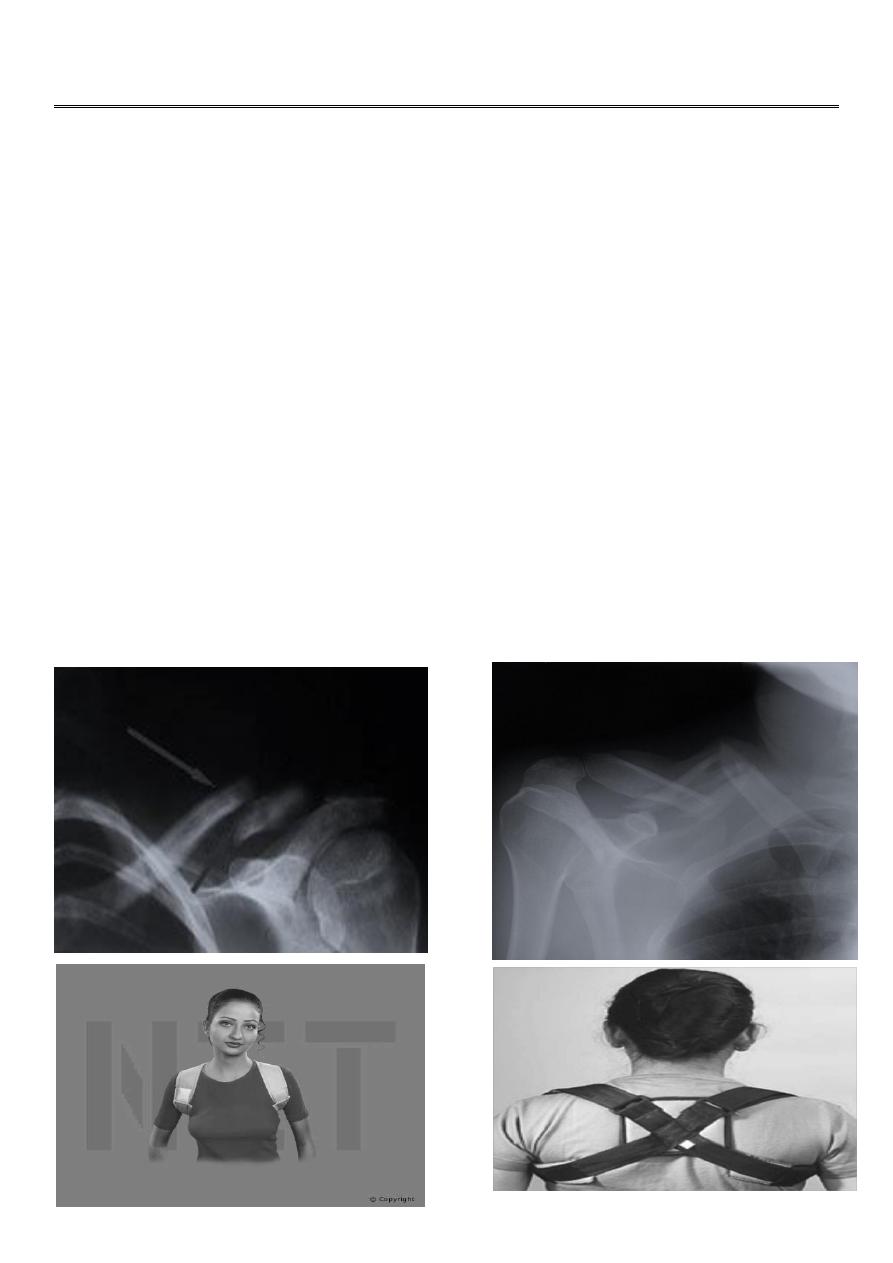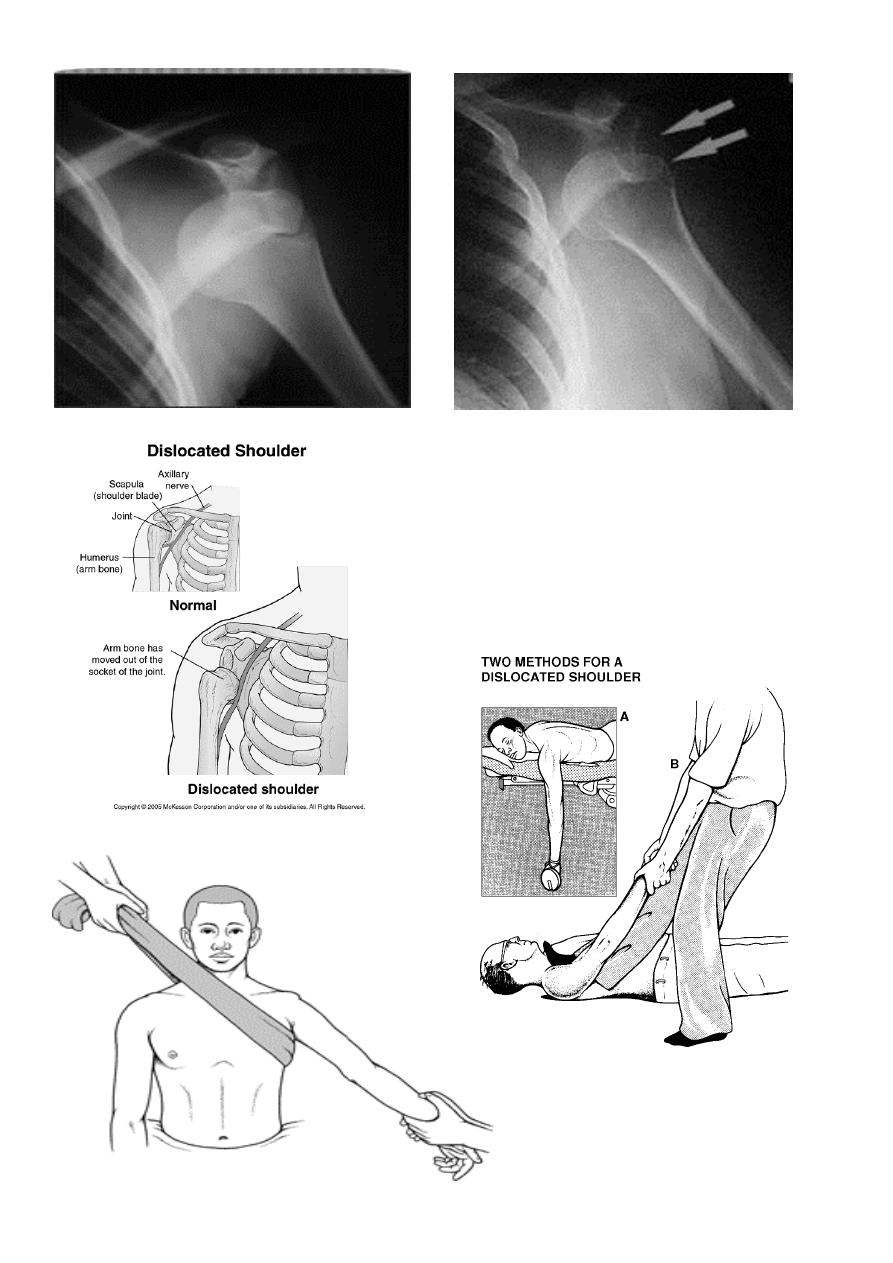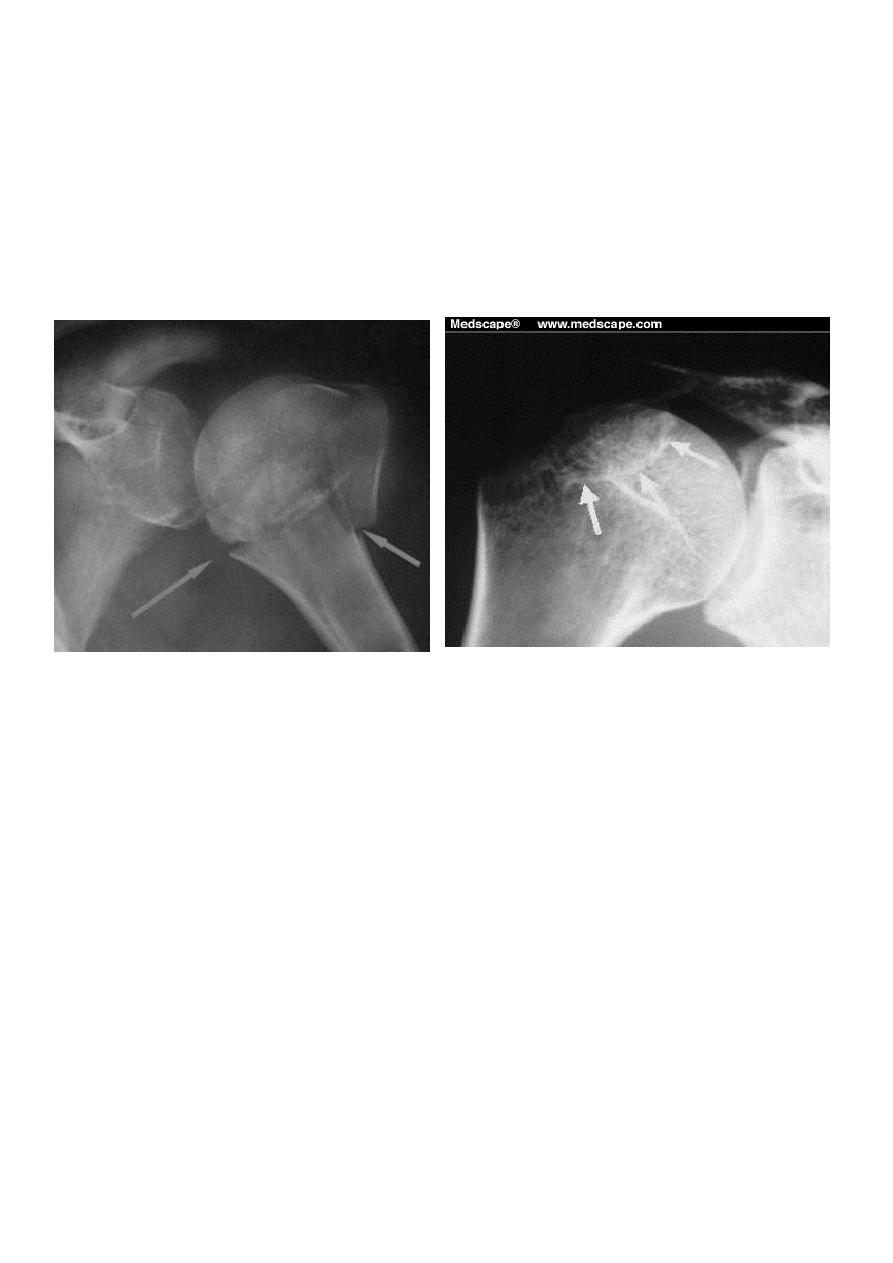
1
Fifth stage
Surgery-Ortho
Lec-7
د.يقضان
29/11/2015
Injuries of the upper limbs
Fracture clavicle
it is occur due to fall on out stretched hands.
The common sites of the fracture in the clavicle is mid shaft .the outer segment displaced
down ward and the medial one displaced upward due to the effect of the sternomastoid
muscle .
Complication :
early :injuries to subclavian artery , brachial plexus , pnemothrax all are rare .
late : malunion , nonunion .
Treatment :
by splinting the arm by sling or by use figure of 8 for one month .
accurate reduction is neither possible nor essential .. If there is complication then open
reduction and fixation (rarely required)

2
Shoulder dislocation
Shoulder joint is the commonest large joint which suffer from dislocation ; due to many
factors like shallow glenoid and its wide range of movements .
Types of shoulder dislocation :
1- anterior dislocation (the commonest) .
2- posterior dislocation (rare) .
3- inferior dislocation (rare) .
Anterior dislocation of the shoulder
It caused by fall on out stretched hand , the head of the humerus driven foreword tearing
the capsule or avulsing the glenoid labrum, and settled under the clavicle in the
infraclavicular fossa .
Clinically :
history of trauma , sever pain , the patient support his arm with the opposite hand and
resist any kind of examination .
On examination :
there is loss of normal contour of the affected shoulder , visible or palpable boney mass
below the clavicle .
Neurovascular examination for axillary nerve and distal pulsation is very important before
any attempt of reduction for medicoleagal purpose.
X –ray :
1- antero-posterior view show the head of the humerus out of the glenoid and located
usually below of the clavicle or the coracoid process .
2- axillary view is very helpful also .
Treatment :
3 methods of reduction :
1- Kocher’s maneuver : most commonly used under general anesthesia , with the
assistant do counter traction, flexion of the elbow 90` and held close to the body , no
traction , slow lateral rotation of the arm then adduction and medial rotation .
1- Hippocratic’s method . Traction on the line of the limb with counter traction .
2- stimson’s technique (gravity) .patient prone the arm hanged beside the bed for 15 –
20 minutes

3

4
Complications :
1) Early :
a) nerves injuries : axillary nerve is the most commonly injured ; the patient is unable to
do contraction of the deltoid muscle and there will be small patch of anesthesia over
the tip of the shoulder . The lesion is usually neuropraxia and recovery will occur
after few weeks
b) vascular injuries : mainly the axillary vessels .
c) rotator cuff tear : there will be difficulty in abduction of the shoulder .
d) associated fractures : fracture proximal humerus , fracture greater tuberosity of hum.
2) Late complication :
a) stiffness of the shoulder .
b) recurrent dislocation . It occur due to avulsion of the labrum or sever tear of the
capsule . It should be treated by surgery.
c) unreduced dislocation .(missed)
Posterior shoulder dislocation
It is rare less than 2% it occur due to marked internal rotation with adduction ; it occur in
Convulsion or with electrical shock .
Clinically :
the arm is held in medial rotationand it locked in that position .
Fracture proximal humerus
This type of fracture occur in old and middle age osteoporotic people .
In the majority of the cases displacement is not marked , only 20% of cases has
considerable displacement .
The fracture occur due to fall on out stretched arm
Proximal humerus include 4 major components these are :
1) head of humerus .
2) greater tuberosity .
3) lesser tuberosity .
4) surgical neck of the humerus .

5
Classification of this fracture called neer classification .
Clinically :
history of trauma , pain ,loss of function , swelling , bruises on the skin , sign of axillary
nerve or brachial plexus injury may be detected .
X-ray :
a-p , lat.view or axillary view should be taken to exclude associated dislocation .
Treatment :
Minimally displaced fracture (majority) need only sling of the arm for 3 weeks until the pain
subside and then gentle passive movement is advised ; active movements is encouraged
after 6 weeks .
If there is considerable displacement of one or more of the 4 components , then
manipulation is advised , if fail then open reduction and fixation .
If the fracture is 4 peaces and displaced and the patient is old then do prosthetic
replacement of the proximal humerus .
Complication :
1) Early : neurovascular injuries (axillary n. , a.)
2) Late :
a) stiffness of the shoulder ; this can minimized by early mobilization .
b) avascular necrosis of the head of the humerus .

6
Fracture shaft of humerus
This fracture caused by fall on out stretched Hands or by direct blow on the arm.
Fracture above the deltoid insertion (deltoid tuberosity), the proximal segment is adducted
by pectoralis major muscle , and if the fracture below the deltoid insertion then the
proximal segment is abducted by the effect of the deltoid muscle .
Injury to the radial nerve is common with this fracture mainly at the junction of the upper
two third and the lower one third of the shaft due to close contact of the nerve to the bone
at that site so it is very important to test for the radial nerve function with this fracture
before and after treatment and this is done by assessing active extension of fingers and
wrist .
Treatment :
1) Conservative treatment : this include hanging cast which is p.o.p cast made from the
arm to the wrist with elbow flexed 90`, the limb is slinged from the wrist so the weight
of the cast will pull the fragments into alignment this can be left for 2-3 weeks and then
replaced by shoulder to elbow cast (u-shape slab) for further 4-6 weeks .
Exercise of the wrist and the fingers should be started from the beginning to avoid
stiffness.
Exercise of the shoulder should be started as early as possible to avoid stiffness( mainly
in elderly)
2) Operative treatment :
Types of fixation :
a- compresion plate and screws .
b-inter locking intra medullary nail .
c- external fixators .
Indications of fixation :
a- sever multiple injuries .
b- open fracture .
c- segmental fracture .
d- pathological fracture .
e- radial nerve palsy after manipulation .
f- non-union .
Complications :
1) Early :
a) 1-vascular injury (brachial artery) .
b) nerve injury ; radial nerve palsy will cause wrist drop .
2) Late complication :
a) delayed union and non union .
b) joint stiffness (minimized by early activity).
